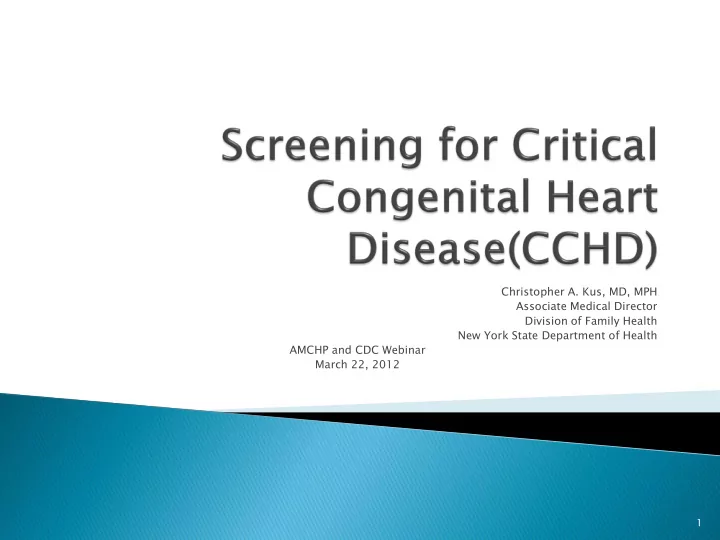

Christopher A. Kus, MD, MPH Associate Medical Director Division of Family Health New York State Department of Health AMCHP and CDC Webinar March 22, 2012 1
Cr Crit itic ical l Co Conge genital ital He Heart rt Dis isease se (CC CCHD HD) ◦ CHDs with severe and life-threatening symptoms requiring intervention within the first year of life Crit itic ical l Conge genita ital l Cyanotic tic Heart Dis isease se (CCCHD) D) ◦ CCHDs that present with hypoxemia in most or all cases CHD affec ects ◦ 7 to 9 of every 1,000 live births in the US ◦ Approximately 25% have CCHD 2
A critical congenital heart defect requiring surgery or catheter intervention in the first year of life that presents with hypoxemia in most or all cases: ◦ Hypoplastic left heart syndrome (HLHS) ◦ Pulmonary atresia, intact septum ◦ Tetralogy of Fallot (TOF) ◦ Total anomalous pulmonary venous return (TAPVR) ◦ Transposition of the great arteries (TGA) ◦ Tricuspid atresia ◦ Truncus arteriosus 3
Octobe ober r 15, 2010 – Secretary’s Advisory Committee for Heritable Disorders in Newborns and Children (SACHDNC) recommends the addition of CCCHD to the Committee’s Recommended Uniform Screening Panel (RUSP) Septembe ber r 21, 2011 – Secretary Kathleen Sebelius adopts the SACHDNC recommendation to add CCHD to the RUSP Novembe ber r 2011 – Strategies for Implementing Screening for Critical Congenital Heart Disease published in Pediatrics 4
Evidence review – CCHD screeni ning ng method Simple, non-invasive, bedside test Estimates percentage of hemoglobin in the blood that is saturated with oxygen Routinely used to monitor infants 5
Renamed the target conditions Critical Care Heart Disease (CCHD) Screening to focus initially on screening in the well-infant nursery & intermediate care nurseries Not to focus on out-of-hospital births Proposed pulse oximetry monitoring protocol based on results for right hand and either foot 6
Po Point-of of care testing ing refers to those tests administered outside of a laboratory but close to the site of direct delivery of medical care for a patient. Different from bloodspot screening which involves a central laboratory. 7
Inform the public about a new screened condition Facilitate standardized implementation of screening Participate in quality assurance Developing systems for diagnostic confirmation, follow-up, and data collection Evaluate the degree to which newborn screening is effective 8
Recommend
More recommend